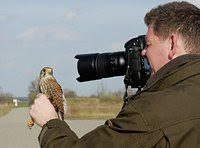
Dear friends,
Among the predators on the African savannahs, spotted hyenas have a unique position. Their expression, appearance, and behaviour are certainly not friendly and to be honest, I don't like them at all. They are most active between dusk and dawn and their typical whooping and giggling calls are often heard at night. Hyenas have the reputation to be scavengers, but most often they hunt their prey by themselves in small packs. It was during a very heavy afternoon rainshower that James, our guide, saw a small pack of hyenas hunting for wildebeest. In a clever way they separated a calf from its group and chased it towards a small ditch of water. There the poor wildebeest stumbled and it was caught by the dominant hyena of the pack. During a short wrestle, the hyena tried to injure the back paw of the wildebeest in order to immobilize its prey.

During the next half hour we witnessed a horrible spectacle. Instead of killing their prey, hyenas start eating their prey alive. The calls of fear and pain of the poor wildebeest were almost unbearable. I had to remind myself constantly that such cruelty also belongs to an African wildlife experience. We hoped that the freightening sounds of the wildebeest would soon come to an end, indicating that the wildebeest had died. Instead, the unfortunate animal was still alive after the hyena had finished one of the back paws! How long would this torture continue?

After half an hour, two lionesses walked decisively to the site of horror. They had probably heard the calling wildebeest from a distance. After a short protest, the hyena slinked off, its head covered with blood. It knew it wouldn't make any chance.
The lionesses checked their capture and found the wildebeest calf still alive. Cats first kill their prey before eating. I felt delighted as the death-struggle would soon come to an end. A few minutes later we left the kill after the lionesses started their diner.
Hyenas have never been my favourite animals. This has certainly not changed after this unforgetable experience. Nevertheless, an African savannah and photosafari isn't complete without them.
Next post will be more friendly. Promised!
Dirk-Jan


























